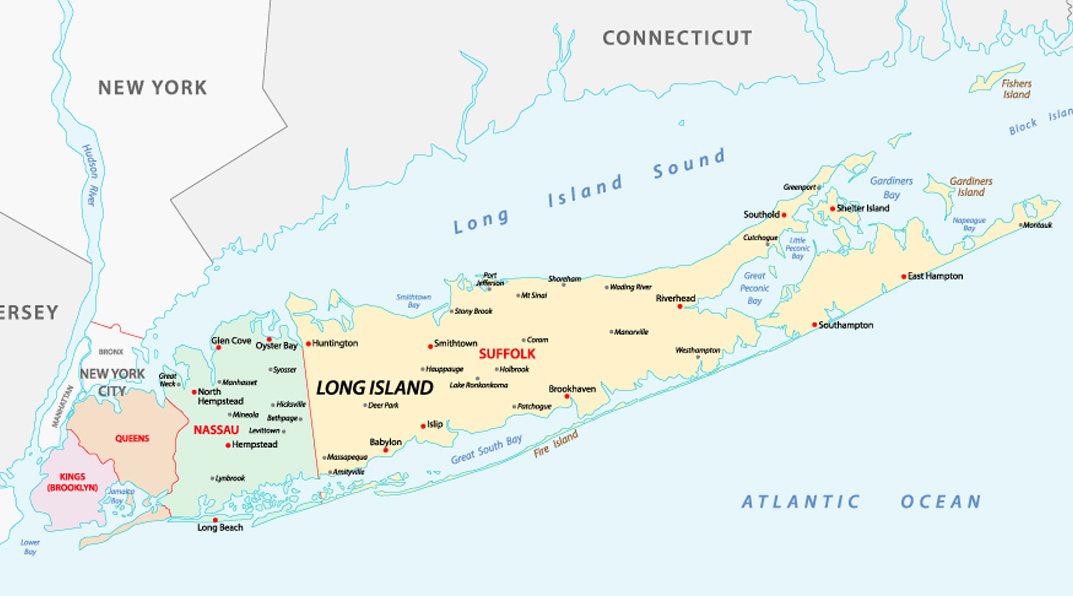Long Island Sound

The Long Island Sound is a tidal estuary (a coastal water body where freshwater from rivers and streams mixes with saltwater from the ocean, influenced by the daily rise and fall of tides. This mixing creates a unique environment called brackish water, which is a mix of fresh and salt water, and it’s often a highly productive ecosystem) located in the northeastern United States, stretching approximately 110 miles from the East River in New York City to Block Island Sound near Montauk Point.
It forms a natural border between the southern coast of Connecticut and the northern shore of Long Island, New York. Bounded to the west by the Bronx and Westchester County, and to the east by the open Atlantic Ocean, the Sound plays a critical role in the geography, economy, ecology, and culture of the region.
Geographically, the Long Island Sound is a semi-enclosed coastal body of water, meaning it is partially open to the sea but mostly surrounded by land. Its width varies from 18 miles at its widest point to as little as 3 miles in the narrowest locations. It covers an area of roughly 1,320 square miles and includes 600 miles of coastline, offering a mix of rocky shores, salt marshes, sandy beaches, and harbors. The Sound is fed by more than 8,000 streams and rivers, most notably the Connecticut River, which supplies a large portion of its freshwater inflow, helping maintain the brackish mix of saltwater and freshwater that defines the estuary.
Formed nearly 20,000 years ago during the last Ice Age, the Long Island Sound originated from glacial activity that carved out deep valleys and deposited sediment, eventually shaping Long Island and the surrounding terrain. Today, it is recognized as one of the most important estuarine systems on the U.S. East Coast due to its biological productivity and diversity. It supports over 1,200 species of invertebrates, 170 species of fish, and dozens of species of migratory birds, many of which use the Sound’s marshes and wetlands as critical habitat for breeding, feeding, and shelter.
The Sound has long been a hub for human activity. Indigenous peoples, including the Montaukett and the Pequot, depended on its rich marine life for sustenance and trade. European settlers established thriving ports along its shores, and today the Sound continues to support a wide range of commercial and recreational uses. Major cities such as Bridgeport, New Haven, Stamford, and Norwalk in Connecticut, and Port Jefferson, Huntington, and Glen Cove in New York, line its coasts. The Sound is home to busy fishing fleets, ferry routes, marinas, and shipping channels, as well as countless private homes, public parks, and waterfront communities.
Boating, fishing, and tourism are central to the Sound’s economy. Anglers fish for striped bass, bluefish, fluke, and black sea bass, while recreational boaters enjoy sailing and kayaking throughout the spring and summer months. Ferry services connect ports like Orient Point and Port Jefferson to New London and Bridgeport, providing vital transit links between Long Island and southern New England. Along the shoreline, destinations such as Caumsett State Historic Park Preserve, Sunken Meadow State Park, and Captain’s Cove Seaport offer scenic views, historical sites, and recreational opportunities for millions of visitors annually.
Ecologically, the Long Island Sound is a designated Estuary of National Significance under the U.S. Environmental Protection Agency’s National Estuary Program. Despite its importance, the Sound has faced decades of environmental challenges, including pollution from stormwater runoff, nitrogen loading from sewage treatment plants, habitat destruction, and overdevelopment along the coast. These issues have led to algal blooms, fish die-offs, and hypoxic conditions in some areas – especially during the summer months when oxygen levels plummet in deeper waters. However, significant efforts have been made in recent years to reverse these trends. Initiatives such as the Long Island Sound Study, a bi-state partnership between New York and Connecticut along with federal agencies, aim to restore and protect the Sound’s water quality and ecological health. Investments in wastewater treatment upgrades, habitat restoration projects, and public education campaigns have led to measurable improvements in many regions of the estuary.
Climate change presents a new and growing set of threats to the Sound. Rising sea levels, warmer temperatures, ocean acidification, and more frequent and intense storms all pose risks to coastal infrastructure, ecosystems, and fisheries. To address this, communities around the Sound are adopting climate resilience plans, elevating homes, restoring dunes and wetlands, and exploring innovative solutions to preserve this vital waterway for future generations.
The Long Island Sound also holds a cultural and literary significance. It has inspired countless artists, writers, and musicians, from 19th-century poets who extolled its tranquil beauty to modern-day conservationists raising awareness of its fragile ecosystems. It remains a symbol of the region’s natural wealth and a reminder of the delicate balance between human development and environmental stewardship.
Whether viewed from a sailboat at sunset, a clifftop hiking trail, or the deck of a ferry crossing from Long Island to Connecticut, the Long Island Sound offers an enduring connection to the coastal heritage of the Northeast. It is both a living ecosystem and a working waterway, deeply woven into the life and identity of the communities that line its shores.

